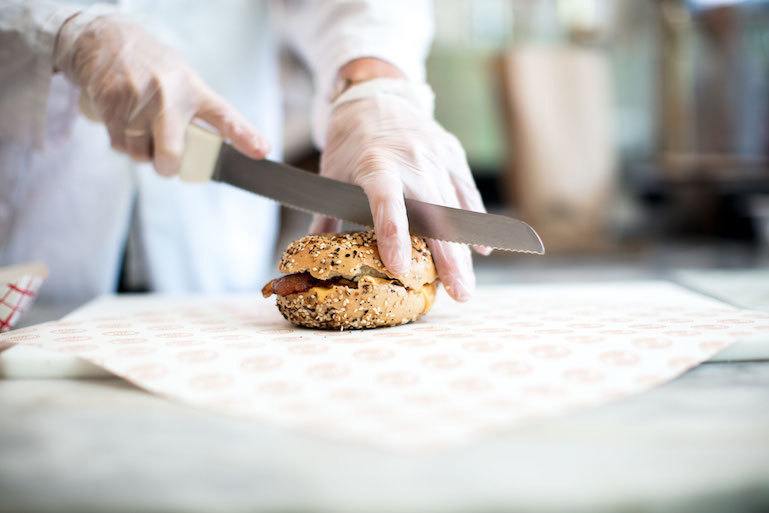
How to Start a Restaurant Without Quitting Your Day Job
Maybe you’re an aspiring restaurateur looking to trade in your paper-pushing, office job for something a little saucier. Or perhaps you’re just curious about what it takes to start a restaurant.
Either way, this guide is your go-to outline for starting a successful restaurant business. Before we dive in, there are a few facts about the restaurant industry we should address so that you make the most informed business decision.
For years, it’s been a widely accepted fact that 1 in 4 restaurants fail within the first year. However, a study by two economists conducted on single-establishment restaurants from 1992-2011, debunked this data. The research shows that only 17% of restaurants close in the first year, not 90% as previously assumed.
The failure rate for full-service restaurants appears to be the same as the failure rate for insurance agencies and brokerages. That said, there are some bitter facts that need to be faced.
The Bitter Truth
The data pulled during this timeframe also shows that restaurants with 20 or fewer employees fail more often than other service businesses.
In addition to this, there are the following industry trends to consider:
Rising labor costs combined with complex federal and state regulations make for a challenging business environment.
Diners are more knowledgeable about food than ever and have come to expect options that accommodate their dietary preferences. To remain competitive, aspiring restaurateurs need to invest in smart technology that empowers them to adapt food concepts quickly and efficiently.
Speed versus savoring is most important to the modern diner. For millennial consumers (18-34 years old), convenience is more important than cuisine.
If you’re starting to feel a little discouraged, don’t throw in the apron just yet. We’ve compiled this easy-to-digest guide to help you get off on the right foot.

Define Your Target Market
One of the biggest mistakes that new restaurateurs make is going into business without having a clear picture of who they are trying to serve. No restaurant appeals to everyone equally, and trying to establish a business that offers something for everyone is the quickest way to skyrocket costs and kill a winning concept.
From dining behaviors to age and income levels, you should dedicate four to five hours a week trying to identify the ideal customer for your future establishment, until you are confident you know exactly who you aspire to serve in your business. These insights will set the foundation for every detail in your business, from choosing a location to creating a winning menu and even hiring the right employees.
SEE ALSO: ShopKeep Guide to Opening a Restaurant
Gain the Right Experience
8 in 10 restaurant owners start in entry-level positions. We’re not suggesting you quit your day job to work full time at the local diner, but picking up few weekend or evening shifts at an eatery that you’ll one day consider the competition is an excellent way to gain first-hand knowledge of the industry while scoping out the potential competition.

Here are a few things you should aim to take away from your experience:
Costs of Goods and Labor: How much will it cost you to purchase food? How many employees will you need? What is the going rate for restaurant managers, kitchen staff, servers, and bartenders in your desired area?
Pricing: What are your competitors currently charging? How much will you need to make from each to be profitable? What percentage are they marking up on each menu item? How is this hurting or helping their business?
Operations: How is the business establishing relationships with reliable suppliers? How can you ensure that you are getting quality ingredients at favorable prices? What insurance or permits are required for the kind of business that you would like to run? What laws and regulations apply to your aspiring restaurant business?
Explore Your Options
Once you have identified your ideal customer, and gained some relevant employment experience, it’s time to explore your options. There are three ways that you can break into the restaurant business. You can:
- Buy into a franchise
- Buy an existing business
- Start your own business
Each of the above options has its pros and cons, however, to summarize, both buying into a franchise and buying into an existing business are often considered less risky since you are investing in proven business models. With that said, in many cases, starting your own restaurant business often turns out to be the most affordable option. Furthermore, starting your restaurant gives you the complete freedom to create your vision, which is probably the biggest appeal of quitting the rat race and starting your own restaurant business in the first place.
Define Your Costs
Due to the unique nature of running a restaurant business, the median cost to open a restaurant is an estimated $275,000. Start-up costs to consider include employee salaries, filing fees, rent, restaurant equipment and supplies, and marketing expenses, just to name a few.
Juggling all of these fluctuating restaurant costs can seem a bit jarring. Luckily, there are several funding options available. Your financing options are likely to fall into the following buckets:
- Equipment financing
- Working capital loans
- Inventory financing
- Lines of credit
Use this short list of funding options as a guide to research and determine the best options for you.
SEE ALSO: Need access to funding? Find out if you qualify for ShopKeep Capital!
Choose a Restaurant Concept
Once you’re ready to turn research into reality, it’s time to choose your restaurant concept. A restaurant concept is the broad theme of your establishment: your cuisine, your service style, even factors like the decor and menu design. This includes everything from the nuances of your menu to the paint on the walls.
Most people have a loose idea of a menu or an innovative service style in mind when they decide to open a restaurant, but it’s also essential to explore the unique aspects of your concept that will attract people to your business as well as the overall objective of your restaurant concept.
Choose a Business Name
The easiest way to go about choosing a business name is to approach the task the same way you approach building new relationships. Here’s what we mean. It takes just one-tenth of a second for us to judge someone based on a first impression. There are endless relationships that instantly blossom or never get off the ground based off of this one simple fact.
Since your business name is often the first thing potential customers will see or hear, think of it as one of your key tools for leaving a lasting first impression. The right name, like a firm handshake, can play a role in your brand’s perception. So make sure it’s catchy and unique, but most importantly sends the right message about your business.
Register Your Business
When you register a business name, you not only comply with laws that require you to take this step, but you also protect yourself. Once you register a name, no one else can use it, this protects your business against anyone else doing business under the same name.
When registering your business name you have three options. You can register a DBA, LLC or trademark your business name.
If you want to operate your business under anything other than your name, you’ll need to register your chosen ‘fictitious’ name with the appropriate county or state authority. This is known as registering a “Doing Business As” (DBA).
This legal name is your first step in separating you and your business as two distinct entities. You will use your DBA name on all legal paperwork and government forms, such as applications for employer tax IDs, licenses, and liquor permits. It is significantly harder to go back and have this applied retroactively, so it’s worth getting it right from the start.
A DBA is necessary in the following situations:
Sole Proprietors or Partnerships: If you are starting a small business under anything other than your real name, you’ll need to register a DBA so that you can do business as another name.
Existing Corporations or LLC: If your business is already set up and you want to do business under a name other than your existing corporation or LLC name, you will need to register a DBA.’
Keep in mind that if you filed to become a corporation or LLC, then you can skip this step altogether.
SEE ALSO: Choosing a Business Name 101
Select the Right Location
Making sure your restaurant business can attract and retain a steady flow of foot traffic is crucial to the success of your business. When choosing your restaurant location, consider the following to improve your chances of attracting a steady flow of customers:
- Does your restaurant location attract your ideal customer? For example: Your location may vary if you’re targeting students than if you’re targeting young professionals.
- Is the location near competing or complementary businesses? For example: If you own a small fashion boutique, choosing an area near a salon, shoe shop or other complimentary business can help attract new customers to your business.
- Is the foot/vehicular traffic ideal? Or is it near public transportation? While retail space in a secluded area may be cost-effective, it’s not necessarily ideal. One of the single most important things for restaurant owners to consider is access and parking for customer vehicles.
Order Equipment
Restaurant equipment is going to be one of your most significant startup expenses. Some of the necessary items you’ll need include:
- Kitchen equipment such as ovens, stoves, grills, fryers, and microwaves.
- Cold storage appliances such as ice machines and walk-in freezers and refrigerators.
- Work surfaces such as countertops, cutting boards, steam tables, and cold food tables.
- Smallwares like sauté and frying pans, sauce pots with lids and baking sheets.
- Utensils for the kitchen such as tongs, ladles, and a good knife set.
- Silverware for the front-of-house along with napkins, tablecloths, and placemats.
- Glassware and barware.
- Furnishings such as tables, chairs, booths, a host stand, and decor.

Hire Staff
According to the National Restaurant Association, the employee turnover rate in the hospitality industry is a whopping 70%. Reliable staff members are hard to come by, especially in such a high-turnover industry. That said, finding the right employees is one of the most critical business decisions you’re going to make.
Your approach to hiring can make or break your business. That’s why we did the heavy lifting for you and created this hiring an employee checklist to ensure no stone goes unturned.
Prepare for Opening Day
So you signed the lease on our ideal location, you’ve hired staff members, set up all of your equipment and you’re ready to open your doors, right? Wrong!
Planning and preparation are essential. Everything you do leading up to opening day should aim at refining the customer experience. This not only means ensuring that the food, service, decor, and atmosphere are up to par but also that staff members are trained and ready to serve with the level of professionalism you expect from your establishment.
Starting a restaurant is no easy feat. Once you’ve taken the steps outlined above, you’ll be a few steps closer to your dream. However, these steps are only the beginning.
Need a point of sale system for your new restaurant? Check out ShopKeep.
Want to try ShopKeep for yourself?
Just answer a few easy questions.
Need help finding the right point of sale?
Just complete the form. We’ll call you right back to explain how ShopKeep can work for you.
Hit the ground running.Sprinting, in fact!
Read our free, comprehensive guide, Small Business 101, to learn all you need to know about starting a thriving business.

